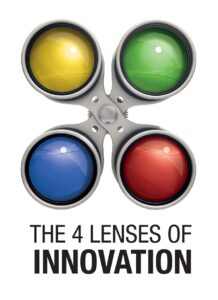The World’s Most Creative
- What does it take to make it into the history books as one of the world’s greatest innovators?
- Do creative geniuses have any unique characteristics?
Rowan Gibson, one of the world’s foremost thought leaders on business innovation, previously shared some of his thinking about his new book, The 4 Lenses of Innovation: A Power Tool for Creative Thinking. Part of what makes his research unique is that he studied innovators throughout history to understand their thinking, their characteristics, and their methodology. What he shared with me about history’s greatest innovators may influence the way you manage, the way you look at your boss, or the way you look at others we label as stubborn. Because, as we will see, the best innovators are often the most unreasonable people.
Why the Best Innovators Are Unreasonable
Rowan, throughout your new book, you give examples ranging from da Vinci to Richard Branson. By studying these innovators, you developed a unique perspective. What does one need to possess or do to get mentioned in the history books?
I think those that make it into the history books are to some extent unreasonable people. George Bernard Shaw put it best when he argued that, “The reasonable man adapts himself to the world; the unreasonable one persists in trying to adapt the world to himself. Therefore, all progress depends on the unreasonable man.” Innovators like the ones I just mentioned – Steve Jobs, Jeff Bezos, Elon Musk –these are not reasonable people. They don’t just accept that the world is the way it is. They have this deep, insatiable urge to improve it or radically change it to fit their own vision of how things should be.
Unreasonable Innovator: Leonardo da Vinci
Take da Vinci. Was he a reasonable person? Here’s a man who filled 13,000 pages of notebooks with scribbles, drawings, scientific diagrams, and designs—everything from human anatomy and facial expressions to animals, birds, plants, rocks, water, chemistry, optics, painting, astronomy, architecture, and engineering. He once coated the wings of a fly with honey just to see if it would change the sound of the fly’s buzzing noise in flight. Why would anyone do that? Da Vinci did it to establish that the pitch of a musical note is connected with the speed of the percussive movement of the air. In this case the fly’s wings became heavier due to the honey, so they couldn’t beat as fast, resulting in a lower-pitched buzzing sound–which of course might be interesting at some level, but reasonable people don’t do things like that.
Unreasonable Innovator: Richard Branson
Let’s say you opened a little record store in London, UK. That’s nothing out of the ordinary. But would you call it “Virgin”? And would you then create your own record label and start backing unknown musicians like Mike Oldfield or controversial bands like the Sex Pistols? Would you try to grow your one little record store into a national chain of media hypermarkets? I mean, if you did all of that, it would be quite remarkable. But would you then decide to start your own transatlantic airline and go up against British Airways on their own turf? Would you try to build your own mobile phone business from scratch and then your own bank or take a big risk by investing in a space tourism company? These are not reasonable things to do. So clearly Richard Branson is not a reasonable man.
Unreasonable Innovator: Elon Musk
Look at Elon Musk. Would you seriously try to build your own rocket company and set out to replace NASA’s space shuttle? Or bring a high-performance electric car to the market when everyone in Detroit tells you you’re going to fail? Or pick a big fight with the national auto dealer association because you want to sell your cars exclusively online? Or go out and build your own electric charging network across the country? Or try to reinvent transportation with a revolutionary concept called “Hyperloop” that most people think is crazy? Again, only an unreasonable person would do things like that.
So if you look at some of the most successful innovators throughout the ages, you would have to conclude that to really get into the history books, you probably have to possess this tendency to be unreasonable about a lot of things and to stubbornly and perhaps obsessively follow your own ideas and instincts.
Why the Best Innovators are Doers
To be cited in The 4 Lenses of Innovation it means not only were you an innovator but also a doer. You made it happen. Many people have great ideas but don’t act on them. How do you develop not only the creative mindset but also the execution skill to match?
In some ways, the execution skills may be harder to improve at an individual level than the creative skills. That’s because execution is more about having the right disposition than about learning and using a specific set of thinking processes to trigger an idea. By disposition, I mean that either by nature or by nurture innovators tend to possess certain personality traits that are critical for making things happen. They are doers rather than dreamers. They are highly self-confident. They are inner directed—they march to the beat of their own drum. They set their own expectations and norms. They are courageous and resilient. They are able to drive an idea forward in the face of opposition and adversity. They are risk-takers with a strong entrepreneurial spirit. They understand that innovation is not just about coming up with ideas but about successfully introducing those ideas. These are attributes that are not so easy to develop.
 That doesn’t mean it can’t be done. Again, we can start with the cultural environment. Is it a place where people are given the necessary time and resources to follow through on their ideas? Are they encouraged to experiment with new things and to pursue potential business opportunities that they themselves have identified? Is it a culture that celebrates entrepreneurial spirit and risk-taking—one where nobody is punished for making mistakes while trying new ideas–a culture where leaders embody and model the right disposition for others to follow and where there is a lot of trust and support for innovative people and their projects? Google has succeeded in creating a culture like this. So has Virgin Group. And W.L. Gore is another example. These are companies where people feel empowered to grow and stretch themselves and to go after big new business opportunities knowing that the organization is behind them. So you can definitely develop and improve these attributes. Individual coaching can help too, and I have seen some people go through a kind of personal transformation as they work on these traits over time.
That doesn’t mean it can’t be done. Again, we can start with the cultural environment. Is it a place where people are given the necessary time and resources to follow through on their ideas? Are they encouraged to experiment with new things and to pursue potential business opportunities that they themselves have identified? Is it a culture that celebrates entrepreneurial spirit and risk-taking—one where nobody is punished for making mistakes while trying new ideas–a culture where leaders embody and model the right disposition for others to follow and where there is a lot of trust and support for innovative people and their projects? Google has succeeded in creating a culture like this. So has Virgin Group. And W.L. Gore is another example. These are companies where people feel empowered to grow and stretch themselves and to go after big new business opportunities knowing that the organization is behind them. So you can definitely develop and improve these attributes. Individual coaching can help too, and I have seen some people go through a kind of personal transformation as they work on these traits over time.
But execution, of course, is not just about individual disposition. Inside a large organization it also requires the right management processes and resources for innovation. It may call for industry partnerships and collaborations. It often requires a multi-functional development team working with everything they need to drive an idea all the way from the mind to the market. So here we’re talking about organizational execution skills as opposed to individual ones. And clearly they are absolutely critical for making innovation happen.

Developing a Creative Mindset
You’ve said that, “Creativity is not a birthright, it’s a skill.” What methods work to develop a creative mindset?
One of the things we know is that cultural environment—and the actual physical design of office space—has a huge impact on mindset and behavior. If you look at Google’s offices around the world, for example, they’re designed to be fun places to work, complete with playrooms, informal spaces, and inspiring breakout areas, where people can regularly relax and spend time thinking creatively together. Google would never have been able to achieve such a highly innovative corporate culture if their offices were dull, formal, and gray, with lots of long, dark corridors and closed doors. So the design of the physical space is a very important component in helping to unlock people’s creativity. It sends out a clear and powerful message that can foster the creative spirit.
Of course, this would all be useless if a company’s management culture itself is not conducive to creative thinking and innovation. So if new ideas are regularly ridiculed or rejected, if standard operating procedures are relentlessly enforced, if it’s all about efficiency and meeting the numbers, if risk-taking and experimentation and failure are punished, then we simply can’t expect people to deploy their creativity at work. Instead, they are going to learn to just shut up and do as they are told and not to rock the boat. Creative thinking requires a culture where people are free to challenge the status quo and suggest different ways of doing things—where they feel that their brainpower is welcome and is being channeled into something exciting and meaningful and where there are few bureaucratic boundaries to get in the way–a culture, in other words, where innovation is not just management rhetoric but a daily reality.
So corporate culture and physical environment certainly play a key role in promoting a creative mindset. But what’s important to understand is not just the environments that enhance our capacity to dream up and introduce new things but also the thinking processes inside the human mind that lead people to their “Eureka moments.” That’s what my new book, “The 4 Lenses of Innovation,” is essentially about. It sets out to identify these thinking processes so that we can actually try to reverse-engineer the mind of the innovator.

Imagine if you could learn to look at a situation or a problem like, say, Steve Jobs, Jeff Bezos, or Elon Musk. How would that improve your ability to discover new insights and opportunities? You know, one of the things that strikes me when we read about innovators like these and their great achievements is that nobody ever tries to analyze the thinking processes that might have led them to their breakthroughs. They don’t ask, “What was this person thinking? How did he or she spot some big opportunity that nobody else seems to have seen? What was the innovator’s angle of view?”
That’s the objective with this new book. Because if we can truly unpack the mind of the innovator, then the great promise is that we can actually teach other people to develop that innovative mindset and those same mental perspectives. We can improve their creative thinking ability, just like teaching them any other skill. I believe we help literally anyone to deliberately and systematically bring out their inner genius.
The 4 Lenses of Innovation: A Power Tool for Creative Thinking

